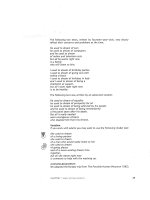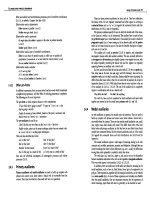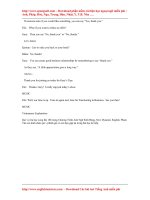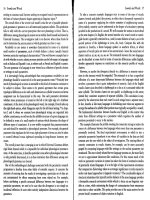Structure question 8 pps
Bạn đang xem bản rút gọn của tài liệu. Xem và tải ngay bản đầy đủ của tài liệu tại đây (81.32 KB, 6 trang )
U
nlike math, writing is flexible. There are many different ways to convey the same meaning. The
THEA Writing section tests your writing skills in two ways. First, it asks you approximately 50 mul-
tiple-choice questions related to writing. You do not need to write out any sentences or paragraphs
for these questions; you simply need to answer the questions correctly by choosing the answer a, b, c,or d.
Each question is based on a passage (you are already familiar with the test format of a passage followed by
questions from the Reading section, no doubt). However, the passages in the multiple-choice Writing section are
shorter than most of those in the Reading section. Another difference is that each part of a passage in the Writ-
ing section is assigned a number, so you can identify specific sentences or sentence fragments.
The second part of the Writing section asks you to write an essay. This essay is evaluated based on your abil-
ity to communicate effectively in writing. You will need to express yourself clearly and correctly in an essay of
approximately 300–600 words. Keep in mind that an average page of handwritten material is approximately 225
words. More important than the essay’s length are its content and organization.
As you study, you may be tempted to focus more on the multiple-choice questions than on the essay, sim-
ply because it’s easier to tell whether you’re correct on a multiple-choice question. This would be a mistake. Your
CHAPTER
THEA Writing
Review
CHAPTER SUMMARY
This chapter covers the topics that will help you succeed on the mul-
tiple-choice and essay portions of the Writing test. You will learn about
grammar, organization, as well as how to recognize your audience.
6
175
score on the essay basically determines whether or not
you pass the whole Writing section. The test scorers will
not even look at your multiple-choice questions unless
your essay earns a borderline score of 5, exactly in
between passing and failing. In that case, the multiple-
choice questions are the determining factor in whether
you pass or fail. But if your essay doesn’t earn a 5, the
multiple-choice questions don’t count at all. So you
should concentrate most of your study time on learn-
ing how to write a good essay.
You can achieve a passing score on the written
essay with a logical arrangement of paragraphs and
ideas that are clearly communicated. Most THEA mak-
ers and English instructors recommend a five-para-
graph essay, which is an easy and acceptable formula.
The five-paragraph essay format helps you to logically
and effectively arrange your ideas, and it gives you a
chance to develop three complete ideas in the middle
three paragraphs.
You will learn more about how to write an effec-
tive essay throughout the next six lessons. However,
before getting into the details of how to communicate
effectively through writing, let us step back and take a
look at the big picture. Before you sit down to write
anything, whether it be an essay for English class, a
shopping list, or a letter to a friend, you need to know
what your purpose for writing that piece is. Not only do
you need to know your purpose for writing, you also
need to recognize your audience. Taking a closer look
at these two keys to effective communication will help
you get off to the right start on any writing task. Under-
standing purpose and audience will also help you to
correctly answer several multiple-choice questions on
the THEA.
Purpose
Every piece of writing has a purpose. Your task as a
writer is to understand why you are writing something;
what is your purpose? You may answer, “It’s to get a
good grade” or “It’s to pass a standardized test” or
something similar. But you have to dig deeper than
these types of responses. Look carefully at the writing
task and ask yourself questions about why you are writ-
ing. Is it to inform someone of something? Is it to per-
suade someone or a group of people? Do you want to
entertain your readers? Do you want to describe some-
thing? If you decide to write a letter to a friend, think
about your purpose. Is it to inform that person of what
is going on in your life? Is it to persuade that person to
accompany you on a date or a trip? Is it to entertain that
person with humorous tales of high school life? As you
can probably see from these examples, a combination
of purposes is often at work in a piece of writing. How-
ever, in most pieces of writing, one main purpose exists.
If you know your main purpose and keep that
purpose in mind throughout a writing task, the end
result will be much more organized and cohesive than
if you sat down and randomly tossed thoughts onto a
piece of paper without a purpose. Having a purpose is
similar to having a goal. It’s something that you can
work toward throughout the planning, writing, and
revising stages of writing an essay. So, write down your
purpose and keep it in front of you as you write your
essay—it will help you to avoid shifts or conflicts in
purpose.
Maintaining Purpose
Maintaining your purpose in an essay is paramount
because if you shift purposes midway through the essay,
your audience will become confused. The key is to be
consistent with your original purpose all the way
through the essay to the very end. For example, say you
start writing an essay with the purpose of persuading
your audience to vote for expanded library privileges
for students. Then, in the middle of the essay you get
overcome with emotion about how upsetting the vot-
ing process is because hardly anyone votes anymore.
Finally, in your conclusion you state that democracy has
failed. Do you think that this essay would achieve the
purpose you set out to achieve at the beginning? Most
likely, the readers of this essay would throw their hands
up in despair and say, “How can I possibly effect any
– THEA WRITING REVIEW–
176
change in library privileges since democracy has failed,
and no one is voting anyway?”
Sample Purpose Question
Read the passage below, written in the style of an intro-
ductory anthropology textbook. Then answer the ques-
tion that follows.
(1) Anthropology is generally considered to be a
social science that interprets and describes the devel-
opment and cultural interactions of humans. (2)
However, some scholars have dubbed it a behav-
ioral science. (3) This is because anthropology stud-
ies the individual in her or his culture. (4) This study
of humans is constantly changing because humans
are constantly changing.
1. Which of the following sentences, if added
between Parts 3 and 4 of the paragraph, would
be most consistent with the writer’s purpose and
intended audience?
a. Margaret Mead was a prominent and influen-
tial anthropologist whom I deeply respect.
b. Regardless of what type of science anthropol-
ogy is, most academics agree that it consists of
the study of humans.
c. Some anthropologists specialize in and pub-
lish articles about linguistics.
d. Radiocarbon dating is sometimes used by
anthropologists who specialize in archaeology
studies.
Answer
The correct answer is b. Several aspects of this sentence
show that it is the correct answer choice. For example,
its beginning transition word, regardless, ties Part 3
and Part 4 together by claiming that it doesn’t matter
what science anthropology is called (either social or
behavioral) since academics agree that it consists of
the study of humans. The term academics echoes the
phrasing of the word scholars in Part 2. The sentence
serves as a cohesive bridge between Part 3 and Part 4.
None of the other answer choices does so. Choice a is
not consistent with the author’s audience—an educa-
tional textbook—because the first person I is used.
Choices c and d mention completely different topics
related to anthropology instead of contributing to a
general overview of the science of anthropology, which
is the writer’s purpose.
If you find that you have several purposes for
writing an essay, rank them in importance, and keep
the main purpose as your overall goal. Each of your
purposes should enhance each other and not detract
from each other. In addition to knowing and main-
taining your purpose in writing, you need to know
who your audience is.
Audience
The audience for your writing is closely tied into your
purpose for writing. If your purpose is to persuade
readers to do something, you need to know who your
readers are. That way, you can specifically target your
message to that audience. For example, if your purpose
is to get people to eat more ice cream, then you need to
know who your audience is. If you are writing to a
group of young children who love to eat ice cream,
your purpose will be quite easily achieved. You won’t
need to include much research or many statistics about
the benefits of eating ice cream. You can instead offer
detailed descriptions of how pleasant it is to eat
ice cream.
On the other hand, if your audience is a group
of adults who are on a diet, you will need to bring in
more elevated powers of persuasion. In fact, you will
probably need to cite several studies and show proof
of how eating ice cream, in balance, is good for them.
Perhaps you can prove that low-fat ice cream has
fewer calories than a hamburger, or you can cite stud-
ies of people who occasionally eat ice cream and still
stay slim. Your writing’s tone, content, and even
– THEA WRITING REVIEW–
177
organization is greatly determined by your audience.
Therefore, keeping your audience in mind throughout
the writing process will help you to become a more
effective communicator.
Practice
Think about the difference in tone, content, and organ-
ization in the following writing tasks. Write down
examples for each task that show the particular tone,
type of content, and overall organization for each. After
you finish, take a moment to think about how different
each writing task is merely because of the audience.
2. You jot down a quick e-mail to a friend.
3. You carefully compose an essay for a college pro-
fessor.
Answers
Answers will vary, but here are some examples.
2. E-mail messages are often written hurriedly and
normally lack formal organization. The e-mail’s
content will vary widely depending on your pur-
pose for sending it. It could be a short, chatty
e-mail that asks a friend a question or makes a
request such as, “Can you help me pick out a
new sweater?”
3. You probably wouldn’t say things like “There-
fore, only the electrons in the outermost shell are
involved” to your friend because the tone is too
formal and the content too academic for light
conversation. However, you could very well
write such a sentence in a formal essay that you
hand in to a college professor because you know
that academic writing takes a formal tone and
uses a standard form of English. Your para-
graphs will be organized, and the final essay will
appear in a standard format for academic
writing.
Audience Questions
Each multiple-choice question in the Writing section
on the THEA that asks about a writer’s purpose and
audience should be looked at carefully. Refer back to the
heading of each passage to see what style it is written in
to help you determine the writer’s purpose and audi-
ence. Additionally, when you take the essay writing
portion of the THEA, be sure to keep your purpose and
audience in mind throughout the writing process.
Purpose and Audience
in Your Essay
Before you begin to write your essay for the THEA, you
should spend the first four or five minutes of the
allowed time to define your purpose for writing the
essay, to identify your audience, and to establish the
appropriate level of formality. Three questions that
will help you to do this are:
1. What is the purpose of my essay?
2. Who is my audience?
3. What level of formality should I use?
The answers to these three questions regarding a
topic on the THEA essay writing section will likely
yield answers, such as:
1. My purpose for writing this essay is to defend my
position on the topic or to persuade my audience
that my position is best.
2. My audience is one or more THEA evaluators,
who are probably English instructors.
3. I should use a formal tone and structure in writ-
ing for this audience and topic.
Now that you are aware of purpose and audi-
ence, the next step is to focus on ideas and ways of
organizing those ideas.
– THEA WRITING REVIEW–
178
Main Ideas and
Organizational Patterns
Now that you’ve mastered purpose and audience, it’s
time to examine main ideas and how to organize those
ideas in a piece of writing. Recognizing main ideas and
organizational patterns will help you to correctly
answer multiple-choice questions on the THEA and
using one or more organizational patterns to order
your main ideas in your essay will help you ace that por-
tion of the test.
Main Ideas
The main idea in a paragraph is often called a topic sen-
tence. The topic sentence normally appears in the first
or last sentence of a paragraph. However, at other times,
the main idea is not specifically stated, but it is implied
in the overall paragraph. In those instances, readers
need to determine the main idea by inference. Without
clear main ideas, an essay will flounder and flop. Let’s
take a look at how you can unify, develop, and support
main ideas to make your essay a sweeping success.
Keeping Main Ideas Unified
A good essay contains main ideas that are unified. This
means that when you write down a main idea in a
paragraph, all the other sentences in that paragraph are
related to that main idea. This creates unity in an essay.
If you write down a main idea and then interject a
completely unrelated sentence in that paragraph, you
will lose your audience, and that will defeat your pur-
pose. So, be sure to maintain unity in your paragraphs.
Developing and Supporting
Main Ideas
Developing main ideas to support your overall purpose
for writing is a challenge. But it is a challenge you can
meet successfully. If you develop your ideas in an
organized way, you will help your readers understand
what you are trying to communicate.
Here are ways you can develop and support main
ideas:
■
Give specific examples. Examples help readers to
understand what writers mean. Examples can also
enhance a reader’s understanding of a complex
subject. Look back through the past few lessons for
the phrase for example, to see this step in action.
■
Supply facts, statistics, or survey results. This is
concrete information that readers will under-
stand. Facts support your case, so use them often.
■
Include anecdotes or personal experiences.
Anecdotes tell a story, and they can illustrate a
point you want to make in an essay. You may also
use personal experience to illuminate a point.
However, don’t rely solely on anecdotes and per-
sonal experience—you need to include other sup-
port as well.
■
Mention specific details. If your main idea is a
sentence that is a general statement, you can sup-
port it by offering several specific details that
show how the general statement is true.
It is essential that you offer support for all main
ideas in the essay that you write for the THEA. You also
need to recognize and use methods for organizing main
ideas, so read on.
Organizational Patterns
An organizational pattern is a way of sequencing or
ordering your ideas in a piece of writing. This section
shows you several organizational patterns that you will
find on the THEA. You should use one or more of
them in your essay. You may be asked to identify them
or to understand their use in a passage on the multiple-
choice portion of the test.
Be aware that organizational patterns related to
writing are also known by other terms, such as “pat-
terns of development”and “methods of organization.”
So if a question asks, “What pattern of development is
the author using?” you will know that the question is
also asking “What organizational pattern is the author
using?” since they mean the same thing.
– THEA WRITING REVIEW–
179
Comparison/Contrast
Using comparison/contrast as an organizational pat-
tern enables you to focus on the similarities and dif-
ferences between two or more topics. For example, you
might want to compare and contrast living in a large
city with living in a small town. You could first list the
comparisons, such as both places have streets, com-
mercial businesses, and residential homes. But you
would probably spend more time developing the con-
trasts between these two subjects, such as level of crime,
job opportunities, and population.
You can use a point-by-point method, in which
you give examples of a similarity between each topic
and then a difference between each topic. Or, you can
list all the similarities between the two topics first, and
then list all the differences.
Chronological
A chronological organizational pattern presents ideas
or events in a linear time frame, that is, their order of
occurrence. It is often used to explain a process or to tell
a story. You might want to use chronological organi-
zation to describe how to bake cookies: “First you pre-
heat the oven, then you gather the ingredients, then you
mix the ingredients and put them in the pan, and
finally, you bake the cookies in the oven.” This shows a
progression of chronological events. You can also use
a chronological pattern to narrate a story, such as “This
morning I woke up and rushed off to the library. After
studying for several hours, I went to the dining hall to
eat lunch. The afternoon was spent in classes and labs.
Then, for dinner I met two friends, and we talked until
nightfall.” Readers can see the progression of events
throughout the day, chronologically.
Classification
An essay that uses classification as an organizational
pattern will likely contain items, topics, or ideas that are
divided into parts or separate categories. If you choose
to use classification as a method of organization, be
sure that your categories are logical and that they don’t
overlap. For example, if you divide books into the
categories of fiction, non-fiction, and romance novels,
you are creating a faulty classification system because
two items in the system overlap—romance novels are
fiction. Each category in a classification system needs to
be logical and complete. To identify a classification
method of organization, look for one general category
that is broken down and divided into separate cate-
gories. For instance, the topic of non-fiction books at
a book sale could be broken down to the separate cat-
egories of memoir, biography, and how-to.
Cause and Effect
Cause and effect is a logical organizational pattern that
explains how one thing or idea results in another thing
or idea. If you use this pattern in your writing, be care-
ful not to make leaps in your reasoning. Each step of the
cause needs to be clearly explained and shown how it
created the effects you describe. You don’t want to leave
out any steps in this process, or you may leave your
readers hanging. Also, include both immediate causes
or effects and long-term causes and effects.
Order of Importance
Ideas listed in their order of importance, either least
important to most important or most important to
least important, create an organizational pattern. The
most effective use of this pattern is to list ideas from
least important to most important because the idea
that is stated last has the most impact on the reader. To
use this pattern of organization, you need to spend
time thinking about the importance of your ideas
before you can determine which idea should be placed
in front of the other. Save the strongest assertion for
last.
General to Specific
The general to specific organizational pattern uses
deductive reasoning. Writers who use this pattern move
from a general statement to specific examples or ideas
that support that general statement. For example, you
might write that Americans need to cultivate better
money-saving habits. This general statement would
– THEA WRITING REVIEW–
180









